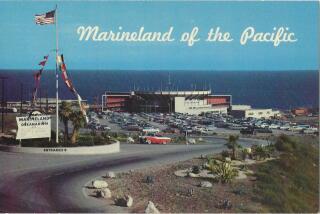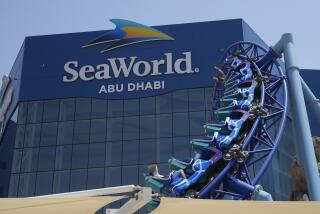Sea World Bears Jovanovich Imprint
William Jovanovich, who describes himself as a “writer and editor,” and HBJ, one of the nation’s largest textbook publishers, entered the entertainment industry in 1976 when the company paid $51 million for three Sea World aquatic parks in San Diego; Orlando, Fla., and Ohio.
It quickly became apparent that the company had stepped onto new ground. A few years after the purchase, a Wall Street analyst began an investors’ report on HBJ by noting that two of the park’s star killer whales had died during the previous fourth quarter.
“I thought it was unusual for a publishing company to be dealing with whales,” the analyst recalled. “And (HBJ) did take a significant (earnings) hit because the whales weren’t covered by insurance.”
More recently, however, analysts have been applauding HBJ’s entrance into the theme and entertainment park business. HBJ’s parks--its sixth will open in April--generated nearly a quarter of the company’s $969 million in 1986 revenue.
Jovanovich, a powerful and idiosyncratic businessman who became HBJ’s chief executive officer in 1954, has personally played a major role in the development of the company’s theme and entertainment parks. HBJ, which now has four Sea World parks, also operates Cypress Gardens and Boardwalk & Baseball, two theme parks in the Orlando area.
Initially, Jovanovich seemed content to leave management of the Sea World parks in San Diego, Orlando and Ohio to park executives. But during the early 1980s, he began to take a hands-on role.
Jovanovich’s increased interest in the parks division may be related to a 1984 decision that stunned the publishing world.
Jovanovich ordered HBJ’s publishing business out of New York, historically the publishing industry capital, to a leased building in Orlando that sits across Sea Harbor Drive from Sea World of Florida, HBJ’s most profitable park.
That year, Jovanovich told HBJ shareholders that the company had “fortified” its publishing management team in order to “free me and (HBJ Parks executive Jack Snyder) to work more closely with Sea World.”
Despite his publisher’s heritage, Jovanovich said he felt comfortable managing entertainment parks. Jovanovich told shareholders that, to HBJ employees and executives who “write, edit, design, promote and sell printed and other graphic works, the functions and forms of operating marine parks . . . are not, to our salutary delight, the least bit foreign.”
Jovanovich’s investment of time corresponded with HBJ’s investment of capital to improve Sea World’s attractions. HBJ has spent $200 million on its three Sea World parks. HBJ is spending an additional $140 million to open the new Sea World park this spring in San Antonio.
During his rare press conference on Dec. 8, the 67-year-old executive said that he has been spending “probably more time with our parks than any other part of our enterprise.”
Changed Logo Design
For the head of the 307th-largest corporation in the United States, the bulk of which is in publishing, Jovanovich has spent an unusually large amount of time on some of the minutest details of park operations. He has changed the design of the Sea World logo and helped to design the large, multicolored map; a nearby fountain, and a retail store at the new entrance to the San Diego park. He has become intimately involved with all aspects of the new San Antonio park.
During the Dec. 8 press conference, he told reporters, “I love detail.”
Former Sea World employees say Jovanovich’s attention to detail sometimes was seen as unnecessary meddling.
Two former employees said park managers were required to submit even modest capital improvement plans to Jovanovich before construction began.
When Sea World was creating a new logo for all its parks that would feature Shamu, the San Diego park’s star killer whale, Jovanovich “at one point changed the color of the stylized blue waves underneath Shamu, and then got out his (ruler) to mark the correct distance between Shamu and the waves,” according to Cinda K. Gregg, who for six years served as corporate director of licensing for Sea World in San Diego.
Jovanovich’s ability to absorb information impressed San Antonians who have dealt with the executive since HBJ first considered moving one of its operations to San Antonio during the early 1980s.
Many corporate executives prefer to leave site selection details to staff professionals, according to Stephanie Coleman, who is president of the Economic Development Foundation, a private group formed to attract corporations to San Antonio. But Jovanovich became involved early on, according to Coleman, visiting the city to inspect a building before his staff had even determined whether to rent or buy.
Coleman, who regularly escorts top corporate executives around San Antonio, described Jovanovich as having an “almost intimidating” desire for details.
‘Precise, Relentless Mind’
“The man has a very precise and relentless mind,” Coleman said. “He has an ability to retain details you might think he’d otherwise forget. He is keenly and genuinely interested in them.”
Jovanovich’s interest in details extended to the workplace, too. He picked the color scheme and artwork for the walls in Sea World’s corporate office in San Diego, according to former employees.
“There were subtle things that he’d do to make a statement,” according to Louise Lacaze, who spent 10 years with Sea World’s marketing department before taking a job with another company. “It was his place, obviously, and he was going to decorate it however he wanted. But change can be unsettling for people who have been there for a long time.”
Jovanovich, in part because of his love of details, has a management style that can be unsettling, according to those who have worked with him. He is not reluctant to fire executives when he feels they have failed to do their jobs.
Fired Top Management
One Saturday night in 1978, Jovanovich fired the entire top management team at HBJ’s general books division. Book publishing company executives still refer to that house cleaning as the “Saturday Night Massacre.”
Jovanovich also has cleaned house at Sea World.
Gregg was fired in 1985, as part of a house cleaning that resulted in the departure of Sea World Chairman Robert R. Hillebrecht, Executive Vice President Frank A. Powell Jr. and Bill Seaton, corporate director of public relations.
Last month, Jovanovich removed San Diego park President Jan Schultz, chief marine biologist Lanny Cornell and chief trainer David Butcher in the wake of a series of injuries to whale trainers.
Firings Spawned Jokes
The pattern of firings has spawned jokes among those familiar with the company. A government official in San Antonio recently offered the following one-liner about Jovanovich: “He likes to hold business meetings on the corporate plane so that he can ask you to step outside if you disagree with him.”
“He is terrific when it comes to hiring (people) and acquiring (properties) but he’s terrible when it comes to managing people,” according to one former employee who worked with Jovanovich.
Competitors know Jovanovich as a fighter who can use words and phrases to cut opponents apart.
In 1981, Jovanovich responded to an evident takeover threat from Warner Communications by describing Warner as a company that had “origins as operators of parking lots and crematoriums.”
Cast Aspersions
When British media tycoon Robert Maxwell recently tried to acquire HBJ, Jovanovich cast aspersions on Maxwell’s origins. “Mr. Maxwell’s dealings since he emerged from the mists of (the Czechoslovakian province of) Ruthenia have not always favored shareholders,” Jovanovich said in a prepared statement.
Jovanovich subsequently defeated Maxwell’s bid for HBJ--but in the process saddled his company with $2.7 billion in debt.
While Jovanovich isn’t shy about expressing his views about competitors, those who have worked with him in the past said that he loathes publicity that could damage HBJ’s core publishing business.
Jovanovich may be tiring of the controversy that Sea World has generated with its attempts to capture or buy additional killer whales for its parks.
Book Boycott Voted
After Jovanovich transferred two killer whales from Marineland in Rancho Palos Verdes, and subsequently closed the aquatic park, the English department at a nearby college voted to boycott HBJ textbooks. Soon after, the Los Angeles Unified School District gave some thought to a boycott of HBJ books.
Several years earlier, when Sea World requested government approval to capture additional whales in Alaska, Jovanovich was “really scared that (environmental groups including Greenpeace) would do something to cause a boycott of HBJ textbooks in Texas,” said one former employee.
A boycott by Texas educators would be frightening to any textbook publisher because many states buy whatever books are approved by that state, according to an executive at a competing textbook company.
Today, Jovanovich seems to have lost some of his enthusiasm for HBJ’s park operations.
“In my opinion, he’s fed up with the theme park business,” HBJ Vice Chairman Robert Edgell said Wednesday. “His first love is publishing. He’s an educator. He would much rather be developing textbooks and magazines” than dealing with the parks.
Jovanovich would consider selling HBJ’s six parks if someone were to offer him $2.5 billion, Edgell said.
Industry analysts last week attacked that price tag as ridiculously high, but Edgell defended it as “the right number.”
More to Read
Inside the business of entertainment
The Wide Shot brings you news, analysis and insights on everything from streaming wars to production — and what it all means for the future.
You may occasionally receive promotional content from the Los Angeles Times.










